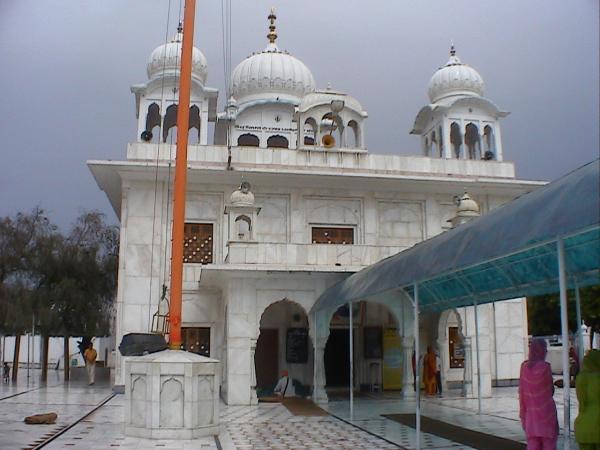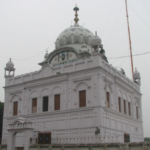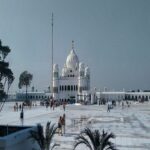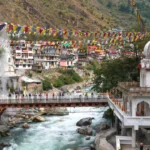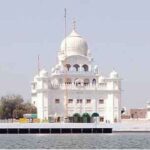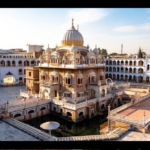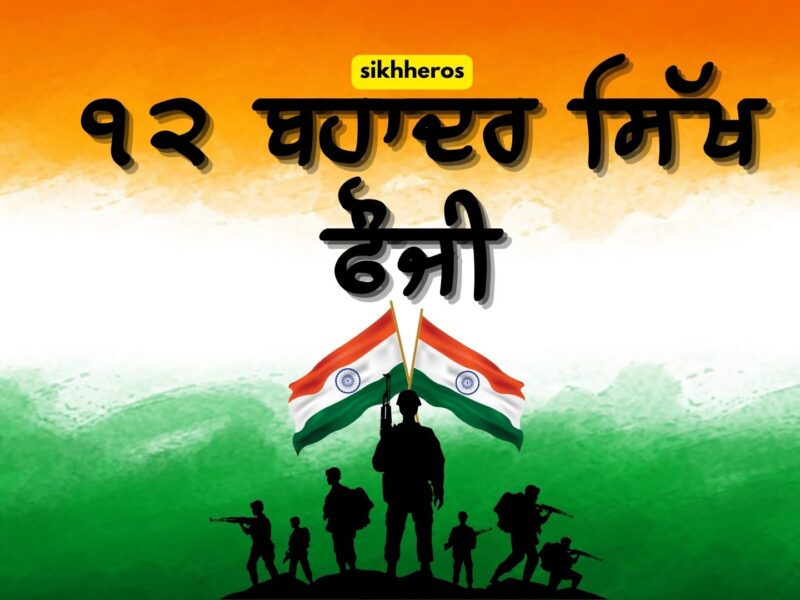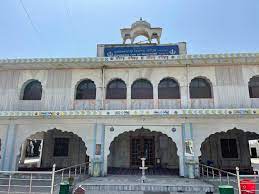Gurudwara Charan Kanwal Sahib, Shri
Gurudwara Maharaja Ranjit Singh erected Charan Kanwal in honor of the sixth Guru, Har Gobind Singh Ji. Guru Ji arrived here after his last fight, in which he killed Pende Khan, and blessed a zamindar, Jeeva, with milk.
Jeendowal, the settlement, was named for him. A large Sarovar (pool) in front of the Gurudwara was created by the daughter of Sardar Dhanna Singh, while the langar was built by Bhai Seva Singh. SGPC is in charge of Gurudwara’s administration.
Gurudwara Shri Charan Kanwal Sahib is located in Nawanshahar Distt’s Banga Town. The Gurudwara Sahib is located on the major road leading to Nawashahr town.
SHRI GURU HARGOBIND SAHIB JI arrived here after beating Painde Khan in the last battle of Kartarpur. At the time, GURU SAHIB WAS ALONG WITH SHRI GURU HAR RAI SAHIB JI, BABA GURDITTA JI, SHRI GURU TEG BAHADUR JI (all in their childhood), and Mata Nanaki ji. GURU SAHIB JI remained for about a month, and his injured horse Suhela was also treated there. This location was named Jindowal after Bhai Jina Ji.
Sri Machhiwara Sahib is a developing city in the Indian state of Punjab’s Ludhiana district. Machhiwara is well-known for Gurudwara Sri Charan Kanwal Sahib, which is affiliated with Guru Gobind Singh ji and called after the Guru’s feet, which are akin to lotus flowers. It is also known for the religious Hindu Sri Shivala Bramchari Temple, which is affiliated with the Pandavas of the Dvapara Yuga (the reign of Lord Krishna).
Emperor Jehangir bestowed the title of Mian on the Ghorewaha. During Emperor Akbar’s reign, the Ghorewaha Raja was Rana Udho II, Raja of Machiwara. Rana Udho actively aided Emperor Akbar in his fight for the Delhi Throne, capturing the rebellious Bairam Khan and consequently allowing the Raja to keep the Jagir of Rahon worth 750 villages.
The Ghorewaha land was divided following Rana Udho’s death, when all of the Branches were Hindu, including that of the famous Rai Rup Chand. Rahon was seized by the Tikka, and Jadla by Bhoj Singh, who had returned from Jaipur.
History
Machhiwara was named after the fish machhi (ground). The Satluj River is 13 kilometers from Machhiwara.
The Battle of Machhiwara (15 May 1555) was fought between Humayun and Afghans.
Humayun conquered Lahore in February 1555, as he struggled to reclaim his control in India. Dipalpur was seized by another detachment of his army. The Mughal army then took over Jalandhar, and their advanced division marched towards Sirhind. Sikandar Shah Suri dispatched 30,000 horses with Naseeb Khan and Tatar Khan, but they were defeated by the Mughal Army in a Battle at Macchiwara.
GURUDWARA SHRI CHARAN KANWAL SAHIB is located in the town of Machiwara in the district of Ludhiana. SHRI GURU GOBIND SINGH JI left the fort of SHRI CHAMKAUR SAHIB and reached hamlet CHUHARPUR, where he sat to relax under a tree, where GURUDWARA SHRI JHAR SAHIB is located, after the martyrdom of his two Sahibjadas and many Sikhs. He traveled from there to the forests of MACHIWARA SAHIB. GURU SAHIB got very close. He drank water from the well, then took tind (a pot that pulls water from the well) and used it as a pillow under the JAND tree to sleep. The old jand tree is still standing.
Gurdwara Sri Charan Kanwal Sahib marks the site of the garden where Sri Guru Gobind Singh Ji stopped first to drink water and rest. This was also where Bhai Daya Singh, Bhai Dharam Singh, and Bhai Mani Singh re-joined Guru Gobind Singh (after an arduous journey through the thorny forest of Machhiwara) as per the Guru’s plan. The well that Guru Gobind Singh drank from still exists and water is provided to visiting Sangats. The Jand tree that Guru Ji rested under is on the left of the Gurdwara Sahib. It is here that the Guru sang the Shabad ‘Mitra Pyare Nu.
The central building of this shrine has a square hall on the ground floor with a square sanctum in the center where Guru Granth Sahib is seated. The domed pavilion over the sanctum on the second floor contains a large portrait of Guru Gobind Singh in a sleeping posture. There are also decorative domed pavilions on this floor, square at the corners and rectangular at the midpoints of the walls.
A rectangular Sarovar, west of the Gurdwara, was constructed during the 1970s. It receives its water supply from an old well believed to be the same as water the garden at the beginning of the eighteenth century. The Gurdwara is controlled by the Shiromani Gurdwara Parbandhak Committee through a local committee that also manages Gurdwara Sri Chaubara Sahib Machhiwara. An annual congregation fair is held in December, corresponding to the 8th and 9th of Poh, the day Guru Ji stayed at Machiwara. In the second story, the domed pavilion over the sanctum houses a colossal image of Guru Gobind Singh in a resting stance. On this floor, there are also ornamental domed pavilions, square at the corners and rectangular at the wall midpoints.
During the 1970s, a rectangular Sarovar was built west of the Gurdwara. It gets its water from an antique well that is thought to be the same one that irrigated the garden in the early eighteenth century. The Shiromani Gurdwara Parbandhak Committee controls the Gurdwara through a local committee, which also manages Gurdwara Sri Chaubara Sahib Machhiwara. An annual congregation fair is held in December, on the 8th and 9th of Poh, when Guru Ji visited Machiwara.
Geography
Machhiwara can be found at 30.91°N 76.2°E. It has a mean elevation of 262 meters (859 feet). Machhiwara is located 38 kilometers northeast of Ludhiana and 69 kilometers west of Chandigarh, the state capital. It is only 9 kilometers from Samrala on the Ludhiana-Chandigarh highway.
Demographics
Machhiwara had a population of 24,916 people according to the 2011 India census. Males make up 13,102 of the population, while females make up 11,814. Dhaliwal, Rathore, and Waraich are the town’s principal Jat clans. Male literacy in Machhiwara is at 77.54%, while female literacy is around 70.56%.
